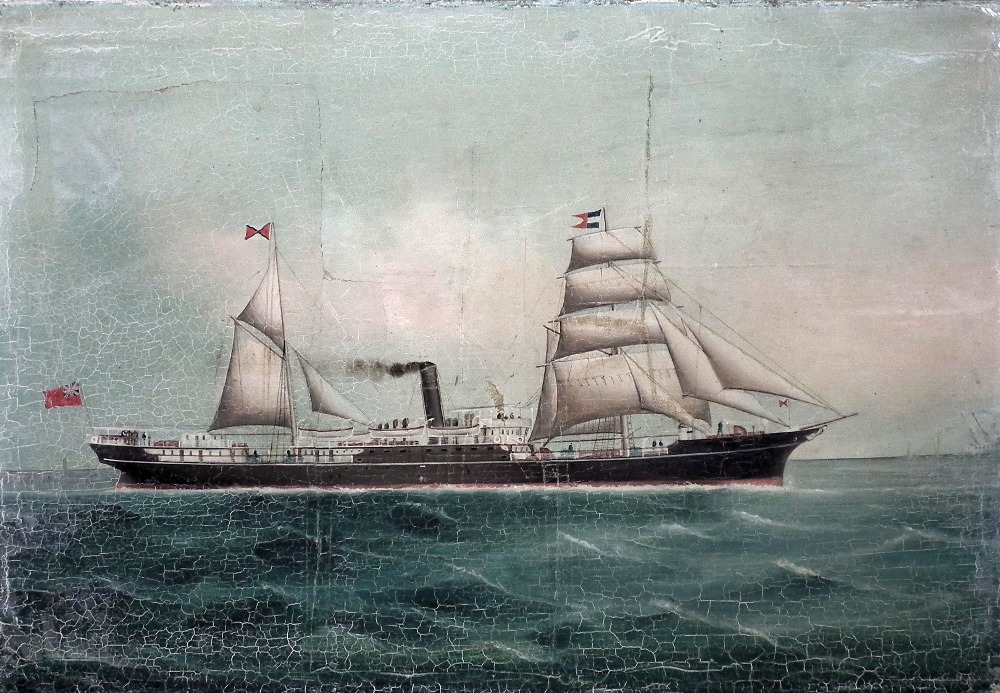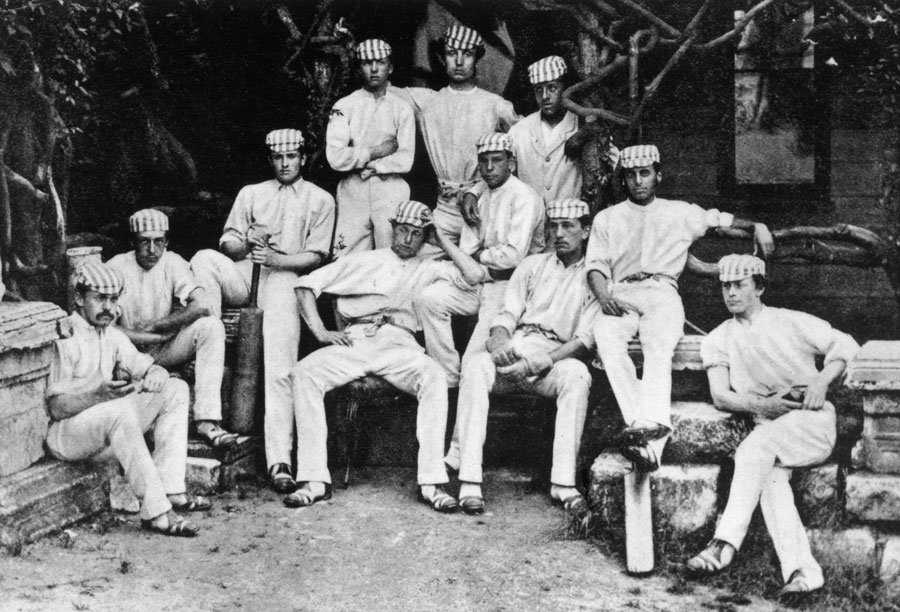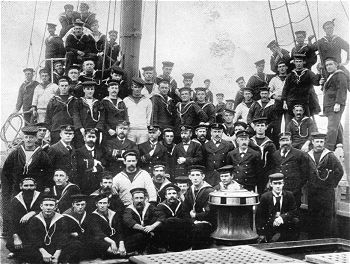|
Apcar And Company
Apcar and Company was a firm founded in 1819 in India that engaged in shipping, import and export. The most profitable trade was in opium, shipped from India to Hong Kong and the Pearl River. The Apcar Line also carried Indian and Chinese laborers for work in Malaya and Singapore. The line was sold to the British India Steam Navigation Company in 1912. Origins Arratoon Apcar was an ethnic Armenian born in 1779 at New Julfa in Isfahan, Persia. He was the second son of Apcar, the ancestor of the family. He came to Bombay when he was sixteen and found employment with an Armenian merchant there, trading with China and Manila. After his patron died, he continued in this trade in his own right. His brother Gregory Apcar came to India in 1808 and joined Arratoon in Bombay. The trading company of Apcar & Co. was founded in 1819 by Arratoon Apcar. Growth Arratoon Apcar moved his company to Calcutta around the end of 1830. In Calcutta the company moved into shipping, carrying both pa ... [...More Info...] [...Related Items...] OR: [Wikipedia] [Google] [Baidu] |
British-India Steam Navigation Company
British India Steam Navigation Company ("BI") was formed in 1856 as the Calcutta and Burmah Steam Navigation Company. History The ''Calcutta and Burmah Steam Navigation Company'' had been formed out of Mackinnon, Mackenzie & Co, a trading partnership of the Scots William Mackinnon and Robert Mackenzie, to carry mail between Calcutta and Rangoon. It became British India SN Co in 1862. Under the hand of Lord Inchcape, who had become chairman in 1913, the company became part of the P&O group of companies in 1914 through a complex amalgamation, but continued with its own identity and organisation for another nearly 60 years until 1972, when it was entirely absorbed into P&O. Fleet and routes As one of the largest shipowners of all time, the company owned more than 500 ships and managed 150 more for other owners. At its height in 1922, BI had more than 160 ships in the fleet, many built on Clydeside, Scotland. The main shipping routes of the line were: Britain to India, Austra ... [...More Info...] [...Related Items...] OR: [Wikipedia] [Google] [Baidu] |
Jardine, Skinner And Company
Jardine, Skinner and Company was a trading company based in Calcutta, India. It was founded in 1825, initially dealing in textiles. Later it branched out into opium, tea, timber and petroleum. The company was closely associated with Matheson & Company of London and Jardine Matheson & Co. of Hong Kong. Early years Jardine, Skinner & Co. was founded in 1825 in Bombay. The early partners of Jardine Skinner were from Scotland, as were the partners of many of the British managing agencies of Bombay and Calcutta. Kinship ties were important, with new members often drawn from Scottish relatives. In 1844 the company was reformed in Calcutta by David Jardine and Charles B. Skinner. David Jardine (1819-1853) was the eldest son of William Jardine's sister Margaret. Jardine Skinner was a merchant and also became a shipping agent and shareholder in shipping companies. The company imported cotton goods from Manchester and Glasgow, and exported indigo, silk, and later jute. Their agents in ... [...More Info...] [...Related Items...] OR: [Wikipedia] [Google] [Baidu] |
Bengal Chamber Of Commerce
The Bengal Chamber of Commerce and Industry is a non-governmental trade association and advocacy group based in West Bengal, India. It is the oldest chamber of commerce in India, and one of the oldest in Asia. Established in 1853, finding its origin in 1833–34, it is the only such institution in India.Welcome to the Bengal Chamber Web Site at bengalchamber.com, accessed 5 January 2011 The organization has its headquarters at the former Royal Exchange in B. B. D. Bagh, Kolkata, which was once the residence of Lord William Bentinck, the first Governor-General of India. Membership The members include corporations and industries of all sizes, professionals, divisions of large multinational corporations and Tertiary sector of the economy, service industry organizations. The corporate members ...[...More Info...] [...Related Items...] OR: [Wikipedia] [Google] [Baidu] |
Apcar Alexander Apcar
Sir Apcar Alexander Apcar (1851 – 17 April 1913) was a wealthy Armenian businessman in Calcutta (now Kolkata), India. His family had made their fortune in the opium trade with China. He was president of the Bengal Chamber of Commerce, sat on the Imperial Legislative Council, and in 1903 was knighted. He owned a racehorse stud, and for several years was the leading figure in the Indian racing world. Early years Apcar Alexander Apcar was of Armenian origin, from a family that settled in Bengal in the early 19th century. His family owned Apcar and Company, which ran a steamship line trading between Calcutta and the treaty ports of China and made its fortune in the Chinese opium trade. He was the second son of Apcar Aratoon Apcar, a merchant whose Apcar Line of steamers traded with Burma, the Straits Settlements and the Far East. Apcar Alexander Apcar was born in Calcutta in 1851. He was educated at Harrow, where he was a contemporary of Lord Curzon. He played for his schoo ... [...More Info...] [...Related Items...] OR: [Wikipedia] [Google] [Baidu] |
Charanpur
Charanpur is a village in the Paschim Bardhaman district of West Bengal, India, about from the industrial town of Asansol. Geography Location Charanpur is classified as an Out Growth (OG) Urban Unit. It has an area of . In 2001 the population was 3,301, of which 1,688 were male and 1,613 female. For postal delivery, Charanpur is a sub-office of the Jamuria Taluk. For other administrative purposes, it is within the Barabani community development block. Pangachhiya, Majiara, Bhanowara, Domohani, Charanpur (OG), Ratibati and Chelad form a cluster of census towns and an outgrowth on the northern and eastern sides of Asansol. Urbanisation As per the 2011 census, 83.33% of the population of Asansol Sadar subdivision was urban and 16.67% was rural. In 2015, the municipal areas of Kulti, Raniganj and Jamuria were included within the jurisdiction of Asansol Municipal Corporation. Asansol Sadar subdivision has 26 (+1 partly) Census Towns.(partly presented in the map along ... [...More Info...] [...Related Items...] OR: [Wikipedia] [Google] [Baidu] |
Sitarampur
Sitarampur is a neighbourhood in Asansol, West Bengal. It is governed by the Asansol Municipal Corporation, and was one of the early hubs of coal mining activity. Geography Location Sitarampur is located at . It has an average elevation of . Urbanisation According to the 2011 Census of India, 83.33% of the population of Asansol Sadar subdivision was urban and 16.67% was rural. The Asansol Sadar subdivision had 26 census towns. Asansol Municipal Corporation According to the Kolkata Gazette notification on 3 June 2015, the municipal areas of Kulti, Raniganj and Jamuria were included within the jurisdiction of Asansol Municipal Corporation. History Coal mines Coal in India was first discovered around Sitarampur. The early mines were Baro Dhemo and Sundarchak, which are now defunct. As those mines started to dry up, new virgin plots were excavated, some of which extended beyond the Damodar River into the Purulia district, and beyond River Barakar into the Nirsa of Dhanba ... [...More Info...] [...Related Items...] OR: [Wikipedia] [Google] [Baidu] |
David Sassoon, Sons & Co
David (; , "beloved one") (traditional spelling), , ''Dāwūd''; grc-koi, Δαυΐδ, Dauíd; la, Davidus, David; gez , ዳዊት, ''Dawit''; xcl, Դաւիթ, ''Dawitʿ''; cu, Давíдъ, ''Davidŭ''; possibly meaning "beloved one". was, according to the Hebrew Bible, the third king of the United Kingdom of Israel. In the Books of Samuel, he is described as a young shepherd and harpist who gains fame by slaying Goliath, a champion of the Philistines, in southern Canaan. David becomes a favourite of Saul, the first king of Israel; he also forges a notably close friendship with Jonathan, a son of Saul. However, under the paranoia that David is seeking to usurp the throne, Saul attempts to kill David, forcing the latter to go into hiding and effectively operate as a fugitive for several years. After Saul and Jonathan are both killed in battle against the Philistines, a 30-year-old David is anointed king over all of Israel and Judah. Following his rise to power, D ... [...More Info...] [...Related Items...] OR: [Wikipedia] [Google] [Baidu] |
Strait Of Malacca
The Strait of Malacca is a narrow stretch of water, 500 mi (800 km) long and from 40 to 155 mi (65–250 km) wide, between the Malay Peninsula (Peninsular Malaysia) to the northeast and the Indonesian island of Sumatra to the southwest, connecting the Andaman Sea (Indian Ocean) and the South China Sea (Pacific Ocean). As the main shipping channel between the Indian and Pacific oceans, it is one of the most important shipping lanes in the world. It is named after the Malacca Sultanate that ruled over the strait between 1400 and 1511, the center of administration of which was located in the modern-day state of Malacca, Malaysia. Extent The International Hydrographic Organization define the limits of the Strait of Malacca as follows: History Early traders from Arabia, Africa, Persia, and Southern India reached Kedah before arriving at Guangzhou. Kedah served as a western port on the Malay Peninsula. They traded glassware, camphor, cotton goods, brocades, ivory, sandalwood, ... [...More Info...] [...Related Items...] OR: [Wikipedia] [Google] [Baidu] |
Penang
Penang ( ms, Pulau Pinang, is a Malaysian state located on the northwest coast of Peninsular Malaysia, by the Malacca Strait. It has two parts: Penang Island, where the capital city, George Town, is located, and Seberang Perai on the Malay Peninsula. They are connected by Malaysia's two longest road bridges, the Penang Bridge and the Sultan Abdul Halim Muadzam Shah Bridge; the latter is also the second longest oversea bridge in Southeast Asia. The second smallest Malaysian state by land mass, Penang is bordered by Kedah to the north and the east, and Perak to the south. Penang is the 8th most populated state in Malaysia. Its population stood at nearly 1.767 million , while its population density was as high as . It has among the nation's highest population densities and is one of the country's most urbanised states. Seberang Perai is Malaysia's second-largest city by population. Its heterogeneous population is highly diverse in ethnicity, culture, language and religion. As ... [...More Info...] [...Related Items...] OR: [Wikipedia] [Google] [Baidu] |
Chapman James Clare
Chapman James Clare (23 June 1853 – 28 September 1940) was a British sailor who worked on merchant vessels, then on Australian government ships, and after formation of the Royal Australian Navy as a senior naval officer. He served during the Boxer Rebellion (1899–1901) and World War I (1914–1918). It was on his suggestion, 1919, that a Coastwatchers organisation should be established. The coastwatchers played an important role during World War II. Early years Chapman James Clare was the son of James Coughron Clare, a merchant ship master. He was born on his father's ship ''Matilda Wattenbach'' on 23 June 1853 in the Bay of Biscay. His father became a lieutenant in the Royal Naval Reserve. Clare was educated in private schools in England at Cheshunt and Municipal Borough of Edmonton, Edmonton. When Clare was fifteen he joined Smith, Fleming & Co. of London as a merchant marine apprentice, and worked on sailing ships for the next five years. In 1873 Clare became mate on a s ... [...More Info...] [...Related Items...] OR: [Wikipedia] [Google] [Baidu] |
Dutch East Indies
The Dutch East Indies, also known as the Netherlands East Indies ( nl, Nederlands(ch)-Indië; ), was a Dutch colony consisting of what is now Indonesia. It was formed from the nationalised trading posts of the Dutch East India Company, which came under the administration of the Dutch government in 1800. During the 19th century, the Dutch possessions and hegemony expanded, reaching the greatest territorial extent in the early 20th century. The Dutch East Indies was one of the most valuable colonies under European rule, and contributed to Dutch global prominence in spice and cash crop trade in the 19th to early 20th centuries. The colonial social order was based on rigid racial and social structures with a Dutch elite living separate from but linked to their native subjects. The term ''Indonesia'' came into use for the geographical location after 1880. In the early 20th century, local intellectuals began developing the concept of Indonesia as a nation state, and set the stage ... [...More Info...] [...Related Items...] OR: [Wikipedia] [Google] [Baidu] |
Southeast Asia
Southeast Asia, also spelled South East Asia and South-East Asia, and also known as Southeastern Asia, South-eastern Asia or SEA, is the geographical United Nations geoscheme for Asia#South-eastern Asia, south-eastern region of Asia, consisting of the regions that are situated south of mainland China, east of the Indian subcontinent, and north-west of mainland Australia. Southeast Asia is bordered to the north by East Asia, to the west by South Asia and the Bay of Bengal, to the east by Oceania and the Pacific Ocean, and to the south by Australia (continent), Australia and the Indian Ocean. Apart from the British Indian Ocean Territory and two out of atolls of Maldives, 26 atolls of Maldives in South Asia, Maritime Southeast Asia is the only other subregion of Asia that lies partly within the Southern Hemisphere. Mainland Southeast Asia is completely in the Northern Hemisphere. East Timor and the southern portion of Indonesia are the only parts that are south of the Equator. Th ... [...More Info...] [...Related Items...] OR: [Wikipedia] [Google] [Baidu] |






